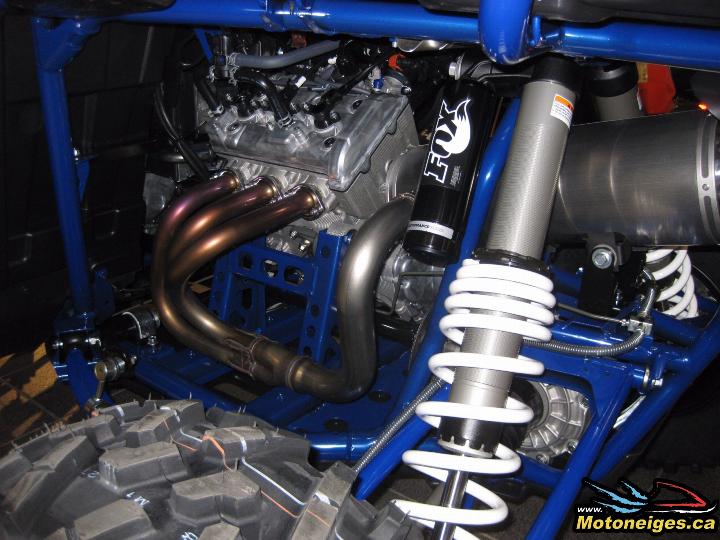Table of contents
ToggleIn February 2013, Yamaha announced to snowmobilers that new models would be introduced each year during the 5 following years. Also, Yamaha people promised to offer at least 2 new engines during the same period of time.
Last September, the Japanese company made quite a remarkable entrance in the ultra-sport side-by-side industry. Effectively, with the introduction of the YXZ 1000, the manufacturer presented a brand new 4-stroke engine of 112 HP. By the way, this is currently the most powerful naturally aspirated engine on the market.
This dry sump engine is very similar to Yamaha snowmobile engines. Then we thought that this same engine could equip the 2017 Yamaha models.
We misread Yamaha’s intentions ! Effectively, Yamaha surprised us with the presentation of a new snowmobile lineup called Sidewinder. The models of this lineup are propelled by the brand new Genesis Turbo engine. According to the manufacturer, this engine could reach, even deliver more than 190 HP on standard units.
Before describing the new models, let’s take a look at the new technologies offered by Yamaha for 2017…
Genesis Turbo engine
To begin, let me be clear, this is a brand new triple engine of 998 cc designed from A to Z to operate with a turbo. In fact, this engine cannot be operated without turbo… So, all components of this engine have been designed with this in mind.

One of the goals pursued by Yamaha engineers was to create a very smooth supercharging system with very quick response, thus to have a turbocharged engine that does not react like a traditional turbo engine. Such an engine could deliver all its power more gradually and more predictably for optimal snowmobile control.
If we compare the power of this new engine with the 1049 cc engine of the SRViper models, we gain 40 % more power (190 vs about 135 HP). Also, its torque is increased by about 50 %. On the following chart, we can also notice the important increase of the torque between 3500 and 4000 RPM.

On trail, we can then expect stronger accelerations at low RPM.
Now, let’s see how Yamaha engineers managed to get these performances.
Exhaust manifold
We have here a 3-in-1 exhaust manifold. It is designed to withstand temperatures over 900 °C and to resist to fatigue produced by repeated expansion and contraction. Also, this manifold is very compact, which allows it to offer to exhaust gas the shortest path to turbine side of the turbo. The energy of these exhaust gas is efficiently transferred to the turbine, which reduces the time of response of the engine.

Turbocharger
The turbine casing is made of nickel alloy that makes it solid and resistant to extremely high temperatures. Balls of ball bearings are made of ceramic. These bearings support the blades made of Inconel; this is a super light alloy resistant to oxidation and corrosion in extreme conditions (pressure and temperature).

The compressor casing is made of die-cast aluminum. Blades are made of aluminum alloy.
Electronic Control Unit (ECU)
The Yamaha Mitsubishi ECU uses 9 sensors to get the conditions of use and to determine the parameters to adjust according to a preset data table. These parameters concern the ignition, the fuel level, the pressure in manifold and the boost pressure to produce for optimal performances.
Data given by sensors :
- Speed of track
- Atmospheric pressure
- RPM
- Engine pre-ignition
- Coolant temperature
- Throttle lever position
- Air temperature in manifold
- Air pressure in manifold
- Boost pressure
Reliability
Reliability has always been an important issue for Yamaha people. In fact, this is the most famous characteristic of their products. So, engineers took this aspect very seriously when they designed this new engine. Here are some components which characteristics prove this intention :
Engine block
The engine block is made of aluminum for more lightness. The internal surface of the cylinders is covered with a ceramic material for excellent resistance to abrasion. Also, cylinders and pistons have the same ratio of thermal expansion. This maximizes the contact surface of the compression in the combustion chamber (reduced loss of compression), which provides a more efficient combustion.

Crankshaft
The crankshaft is designed to resist to stress produced by boosted engine. This crankshaft is also used in the YXZ 1000 engine we talked about earlier. Yamaha representatives told us that using the same component brings noticeable economies of scale. This said, using some components in a few engines is their only common element.

Piston rods
The new pistons are made of forged aluminum and designed to be lightweight and resistant. Their lightness improves the time of response of the engine all while reducing vibration.

Pistons
The new pistons are made of forged aluminum and designed to be lightweight and resistant. Their lightness improves the time of response of the engine all while reducing vibration.

Pistons are also cooled by sprinklers that throw oil underneath them. Along with cooling the pistons, the oil provides good lubrication. This system allowed Yamaha to use lighter pistons.

Counter-balancing shaft
For smoother engine operating at high RPM, a counter-balancing shaft is used. This reduces vibration, which improves riding experience.

New YSRC clutching
In order to maximize the engine performances, the pulleys efficiency is very important. This is the reason why Yamaha decided to introduce a new clutch system. The primary clutch has been designed to be used with more powerful engines. Effectively, it is more robust, more efficient and provides better cooling.
The secondary clutch has new plates with different angles. Also, there are small edges for an improved cooling since it increases air flow. Pads have also been replaced by rollers.

In short, this new clutch system allows :
- Improved cooling
- Usage in a wider range of power
- More efficient gear shifting
- More robust design
- Better adjustment of the width of plates
- Excellent duration of the belts
Finally, these pulleys require very low maintenance.
And now, here is the Sidewinder !
As for the SRViper lineup, the Sidewinder models are produced within the supply agreement between Arctic Cat and Yamaha. So, the development of the Genesis Turbo engine has been achieved in collaboration with the manufacturer from Thief River Falls, would it be only for its adjustment to the SRV chassis.
However, some elements make the Sidewinder different from the SRViper, like :
- New panels (a new look)
- Engine exhaust pointing backwards
- New silencer
- New clutches
- New belt (change of angles)
- New heat exchanger (radiator)
There is a Sidewinder for everyone
For this first year of production, Yamaha spared no expense to choose which segment-s of the lineup would receive a Sidewinder model. Effectively, including the models available during Spring Power Surge, not less than 12 new models will be offered for 2017. So, here is the complete lineup of Sidewinder models :
Sidewinder R-TX LE (Trail)
- Ripsaw II track of 29 x 1.25 in/328 x 3,2 cm
- Ski stance of 42 in/106,7 cm
- Fox Zero QS3 Kashima shocks
- Heated seat
- Low windshield

Sidewinder R-TX LE
Sidewinder R-TX SE (Trail)
- Ripsaw II track of 129 x 1.25 in/328 x 3,2 cm
- Ski stance of 42 in/106,7 cm
- Fox Zero C shocks
- Medium windshield

Sidewinder R-TX SE
Sidewinder L-TX LE
- Ripsaw II track of 137 x 1.25 in/348 x 3,2 cm
- Ski stance of 42 in/106,7 cm
- Fox Zero QS3 Kashima front shock
- Heated seat
- Low windshield

Sidewinder L-TX LE
Sidewinder L-TX SE (Trail)
- Ripsaw II track of 137 x 1.25 in/348 x 3,2 cm
- Ski stance of 42 in/106,7 cm
- Fox Zero C shocks
- Medium windshield

Sidewinder L-TX SE
Sidewinder L-TX DX (Trail)
- Ripsaw II track of 137 x 1.25 in/348 x 3,2 cm
- Ski stance of 42 in/106,7 cm
- Alu HP shocks
- Tall windshield

Sidewinder L-TX DX
Sidewinder S-TX DX (Trail – Touring solo)
- Cobra track of 137 x 1.6 in/348 x 4 cm
- Ski stance of 42 in/106,7 cm
- Alu HP shocks
- Tall windshield
- Large tunnel bag
- 2 removable saddlebags

Sidewinder S-TX DX
Sidewinder X-TX LE 137 (Hybrid)
- BackCountry track of 137 x 1.75 in/348 x 4,4 cm
- Ski stance of 42 in/106,7 cm
- Fox Zero QS3 shocks
- Low windshield

Sidewinder X-TX LE 137
Sidewinder X-TX LE 141 (Hybrid)
- Power Claw track of 141 x 2.25 in/358 x 5,7 cm
- Ski stance of 40 in/101,6 cm
- Fox Float Evol shocks
- Heated seat
- Low windshield

Sidewinder X-TX LE 141
Sidewinder X-TX SE 141 (Hybrid)
- Cobra track of 141 x 1.6 in/358 cm x 4 cm
- Ski stance of 42 in/106,7 cm
- Fox Zero C shocks
- Medium windshield

Sidewinder X-TX SE 141
Sidewinder B-TX LE 153 (Hybrid – Mountain)
- Power Claw track of 153 x 2.25 in/388,6 x 5,7 cm
- Ski stance of 40 in/101,6 cm
- Fox Float Evol shocks
- Heated seat
- Low windshield

Sidewinder B-TX LE 153
Sidewinder B-TX SE 153 (Hybrid – Mountain)
- Power Claw track of 153 x 1.75 in/388,6 x 4,4 cm
- Ski stance of 40 in/101,6 cm
- Fox Float 3 shocks
- Low windshield

Sidewinder B-TX SE 153
Sidewinder M-TX SE 162 (Mountain)
- Power Claw track of 162 x 3.0 in/411,5 x 7,6 cm
- Ski stance of 36 in/91,4 cm
- Fox Float 3 shocks
- Low windshield

Sidewinder M-TX SE 162
Our first impressions
On the day this article is being written, we did not have the chance yet to try out the new Sidewinder or even to see it for real… Effectively, at the media presentations of last January, there was no unit in the show room… Too new ?
However, when this article will be published, some delegates of SledMagazine.com will be attending the 2017 Snow Shoot in West Yellowstone, Montana. Then, we will be able to present our first impressions very soon.


